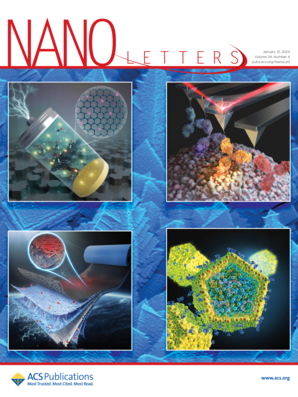In Situ Grain Boundary Engineering Enabling Ultralong Stable Cycling Garnet-Based Solid-State Electrolytes
IF 9.6
1区 材料科学
Q1 CHEMISTRY, MULTIDISCIPLINARY
引用次数: 0
Abstract
Solid-state lithium metal batteries (SSLMBs) are promising next-generation energy storage due to their high safety and energy density, but lithium dendrite growth in solid electrolytes hinders their application. We propose an in situ grain boundary (GB) modification strategy using LiTaO3 (LTO) reacting with Ta-doped garnet electrolyte to form a pseudocrystal Li3TaO4/Zr3O (LZT) phase at GBs. The LZT phase reduces electronic conductivity, inhibits abnormal grain growth, strengthens GBs bonding, and enhances fracture toughness, effectively suppressing dendrite formation. The modified electrolyte (2LTaO) achieves an ultralow electronic conductivity of 8.58 × 10–9 S cm–1. Symmetrical Li | 2LTaO | Li cells demonstrate a high critical current density of 2.2 mA cm–2 and stable cycling for 12,000 h at 0.3 mA cm–2. Full cells exhibit excellent cycling stability and rate performance. This strategy provides a promising approach for the development of high-performance SSLMBs.

求助全文
约1分钟内获得全文
求助全文
来源期刊

Nano Letters
工程技术-材料科学:综合
CiteScore
16.80
自引率
2.80%
发文量
1182
审稿时长
1.4 months
期刊介绍:
Nano Letters serves as a dynamic platform for promptly disseminating original results in fundamental, applied, and emerging research across all facets of nanoscience and nanotechnology. A pivotal criterion for inclusion within Nano Letters is the convergence of at least two different areas or disciplines, ensuring a rich interdisciplinary scope. The journal is dedicated to fostering exploration in diverse areas, including:
- Experimental and theoretical findings on physical, chemical, and biological phenomena at the nanoscale
- Synthesis, characterization, and processing of organic, inorganic, polymer, and hybrid nanomaterials through physical, chemical, and biological methodologies
- Modeling and simulation of synthetic, assembly, and interaction processes
- Realization of integrated nanostructures and nano-engineered devices exhibiting advanced performance
- Applications of nanoscale materials in living and environmental systems
Nano Letters is committed to advancing and showcasing groundbreaking research that intersects various domains, fostering innovation and collaboration in the ever-evolving field of nanoscience and nanotechnology.
 求助内容:
求助内容: 应助结果提醒方式:
应助结果提醒方式:


